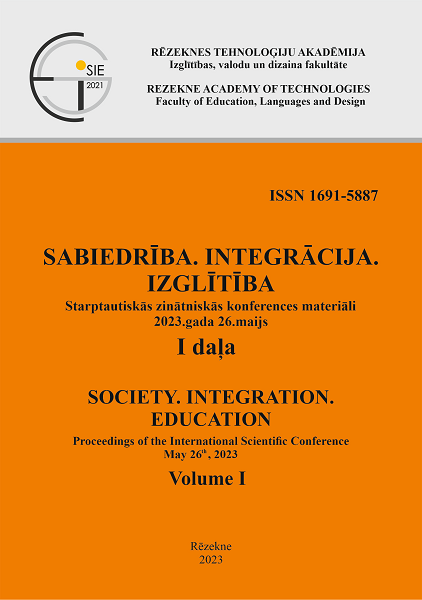HOW STUDENTS ARE LEARNING TO REASON IN MATHEMATICS LESSONS
DOI:
https://doi.org/10.17770/sie2023vol1.7087Keywords:
lesson observation, mathematical reasoning, primary education, teacher performanceAbstract
The goal of mathematics teaching in primary school is not just to acquire knowledge of mathematical ideas and procedures, but also to learn mathematical reasoning. While this is common knowledge, the reality in everyday primary math classrooms in Latvia is an open question. The results from recent national diagnostics give reason to re-examine common teaching practices. The aim of this study is to clarify what is happening in primary math classrooms and to understand the needs and gaps in mathematics teaching. This will serve as the basis for designing appropriate professional development for teaching mathematical reasoning. In this study researchers observed and transcribed primary math lessons. Teacher performance was appraised using “Framework for teacher performance assessment to support teaching 21st century skills”. The criteria used to assess teacher techniques were lesson design and clarity of learning content as well as student cognitive activation. The results of this preliminary study show that separate elements of student reasoning are present in lessons.
References
Alfieri, L., Brooks, P. J., Aldrich, N. J., & Tenenbaum, H. R. (2011). Does discovery-based instruction enhance learning?. Journal of educational psychology, 103(1), 1.
Anderson, N. (2021). Keep calm and press for reasoning. Mathematics Teacher: Learning and Teaching PK-12, 114(8), 591-597.
Bērtule, D., Dudareva, I., Namsone, D., Čakāne, L., & Butkēviča, A. (2019). Framework of Teacher Performance Assessment to Support Teaching 21st Century Skills. Proceedings for International Technology, Education and Development (INTED).
Bronkhorst, H., Roorda, G., Suhre, C., & Goedhart, M. (2020). Logical reasoning in formal and everyday reasoning tasks. International Journal of Science and Mathematics Education, 18, 1673-1694.
Fiorani, H. (2014). Hands-On Math in Kindergarten. In K-12 Education: Concepts, Methodologies, Tools, and Applications (pp. 1604-1614). IGI Global.
Forman, E. A., & McPhail, J. (1993). Vygotskian perspective on children's collaborative problem-solving activities. Contexts for learning: Sociocultural dynamics in children's development, 213-229.
Gagne, R. M., Briggs L. J. & Wager, W. W. (1992). Principles of Instructional Design. Harcourt Brace College Publishers.
Glasersfeld, E. V. (1989). Constructivism in education. In: Husen T, Postlethwaite TN (eds) The international encyclopedia of education, supplement, vol 1. Pergamon Press, Oxford/New York, pp. 162–163.
Halpern, D. F. (2013). Thought and knowledge: An introduction to critical thinking. Psychology Press.
Huinker, D. & Bill, V. (2017). Taking Action: Implementing Effective Mathematics Teaching Practices in K—Grade 5. National Council of Teachers of Mathematics.
Namsone, D., Čakāne, L., & Eriņa, D. (2021). Theoretical Framework For Teachers Self-Assessment To Teach 21st Century Skills. In Society. Integration. Education. Proceedings of the International Scientific Conference, Vol. 2, pp. 402-429.
Ministru kabinets. (2019). Noteikumi par valsts vispārējās vidējās izglītības standartu un vispārējās vidējās izglītības programmu paraugiem, Nr.416. Pieejams: https://likumi.lv/ta/id/309597-noteikumi-par-valsts-visparejas-videjas-izglitibas-standartu-un-visparejas-videjas-izglitibas-programmu-paraugiem
Oliņa, Z., Namsone, D., & France, I. (2018). Kompetence kā komplekss skolēna mācīšanās rezultāts. No D. Namsones (sast.) Mācīšanās lietpratībai, 18-43. LU Akadēmiskais apgāds.
Organisation for Economic Co-operation and Development. (2017). PISA 2015 Assesment and Analytical Framework: Science, Mathematic, Financial Literacy and Collaborative Problem Soving, revised edition. Paris: PISA, OECD publishing.
Organisation for Economic Co-operation and Development. (2018). PISA 2022 MATHEMATICS FRAMEWORK (DRAFT). OECD. Retrieved from: https://pisa2022-maths.oecd.org/files/PISA%202022%20Mathematics%20Framework%20Draft.pdf
Skemp, R. R. (1987). The Psychology of Learning Mathematics. Penguin Books.
Thompson, P. W. (2020). Constructivism in mathematics education. In Encyclopedia of mathematics education (pp. 127-134). Cham: Springer International Publishing.
Uttal, D. H., Liu, L. L., & DeLoache, J. S. (1999). Taking a hard look at concreteness: Do concrete objects help young children learn symbolic relations? In L. Balter & C. S. Tamis-LeMonda (Eds.), Child psychology: A handbook of contemporary issues (pp. 177–192). Psychology Press.
Valsts izglītības satura centrs. (2018). Matemātika 1.–9. klasei. Mācību priekšmeta programmas paraugs. Skola 2030. Pieejams: https://mape.skola2030.lv/resources/159
Van de Walle, J. A., Karp, K. S., & Bay-Williams, J. M. (2019). Elementary and middle school mathematics. London: Pearson Education UK.
Vygotsky, L. S. (1978). Mind in society: The development of higher psychological processes. Cambridge, MA: Harvard University Press.
Wood, T., & Tumer-Vorbeck, T. (2014). Extending the conception of mathematics teaching. In Beyond classical pedagogy (pp. 199-222). Routledge.






